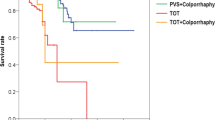Abstract
Introduction and hypothesis
The suburethral sling procedure has been widely used as the first-line treatment for stress urinary incontinence (SUI) in women. Although the success rate is high, difficult urination and urine retention can occur in a small portion of patients. A transvaginal sling incision can solve this problem but recurrent SUI may occur. This study investigated the long-term outcomes of women who underwent the pubovaginal sling (PVS) procedure and subsequent transvaginal sling incision for urethral obstruction.
Methods
We retrospectively reviewed the voiding conditions of women who underwent transvaginal sling incision owing to bladder outlet obstruction after the PVS procedure over the past two decades. Urodynamic study was performed before and after each operation. The patients’ Global Impression of Improvement (PGI-I) and quality of life index (QoL-I) due to urinary symptoms were used for outcome evaluation.
Results
Among 405 women who underwent PVS procedure, 14 (3.5%) underwent subsequent transvaginal sling incision. The main symptoms were severe dysuria, followed by urinary retention or severe wound discomfort. The average interval between the two operations was 147.6 ± 353.6 days (range 3~1,344). The mean follow-up time after sling incision was 91.1 ± 50.7 months. At follow-up, 12 patients (85.7%) could maintain urinary continence whereas 2 had urgency incontinence. Ten patients (71.4%) were satisfied with their quality of life postoperatively.
Conclusions
Transvaginal sling incision is effective for urethral obstruction after PVS procedure. Voiding dysfunction after PVS could be resolved via sling incision. Most patients could maintain urinary continence and reported good satisfaction.

Similar content being viewed by others
References
Cox A, Herschorn S, Lee L. Surgical management of female SUI: is there a gold standard? Nat Rev Urol. 2013;10:78–89.
Patel BN, Kobashi KC, Staskin D. Iatrogenic obstruction after sling surgery. Nat Rev Urol. 2012;9:429–34.
Mcguire EJ, Lytton B. Pubovaginal sling procedure for stress incontinence. J Urol. 1978;119:82–4.
Kuo HC. Comparison of video urodynamic results after the pubovaginal sling procedure using rectus fascia and polypropylene mesh for stress urinary incontinence. J Urol. 2001;165:163–8.
Kuo HC. Anatomical and functional results of pubovaginal sling procedure using polypropylene mesh for the treatment of stress urinary incontinence. J Urol. 2001;166:152–7.
Kuo HC. The surgical results of the pubovaginal sling procedure using polypropylene mesh for stress urinary incontinence. BJU Int. 2001;88:884–8.
Nitti VW, Carlson KV, Blaivas JG, Dmochowski RR. Early results of pubovaginal sling lysis by midline sling incision. Urology. 2002;59:47–51.
Song PH, Yoo ES. Five-year outcomes of the transection of synthetic suburethral sling tape for treating obstructive voiding symptoms after transobturator sling surgery. Urology. 2012;80:551–5.
Farrar DJ, Osborne JL, Stephenson TP, Whiteside CG, Weir J, Berry J, et al. A urodynamic view of bladder outflow obstruction in the female: factors influencing the results of treatment. Br J Urol. 1975;47:815–22.
Chassange S, Bernier PA, Haab F, Roehrborn CG, Reisch JS, Zimmern PE. Proposed cut-off values to define bladder outlet obstruction in women. Urology. 1998;51:408–11.
Klutke C, Siegel S, Carlin B, Paszkiewicz E, Kirkemo A, Klutke J. Urinary retention after tension-free vaginal tape procedure: incidence and treatment. Urology. 2001;58:697–701.
Laurikainen E, Kiilholma P. A nationwide analysis of transvaginal tape release for urinary retention after tension-free vaginal tape procedure. Int Urogynecol J Pelvic Floor Dysfunct. 2006;17:111–9.
Hong B, Park S, Kim HS, Choo MS. Factors predictive of urinary retention after a tension-free vaginal tape procedure for female stress urinary incontinence. J Urol. 2003;170:852–6.
Foster HE, McGuire EJ. Management of urethral obstruction with transvaginal urethrolysis. J Urol. 1993;150:1448–51.
Goldman HB, Rackley RR, Appell RA. The efficacy of urethrolysis without re-suspension for iatrogenic urethral obstruction. J Urol. 1999;161:196–8.
Ulrich D, Bjelic-Radisic V, Höllein A, Trutnovsky G, Tamussino K, Aigmüller T. Quality of life and objective outcome assessment in women with tape division after surgery for stress urinary incontinence. PLoS One. 2017;27:12:e0174628.
Hsiao SM, Lin HH, Kuo HC. Videourodynamic studies of women with voiding dysfunction. Sci Rep. 2017;7:6845.
Jiang YH, Kuo HC. Video-urodynamic characteristics of non-neurogenic, idiopathic underactive bladder in men—a comparison of men with normal tracing and bladder outlet obstruction. PLoS One. 2017;12:e0174593.
Author information
Authors and Affiliations
Corresponding author
Ethics declarations
Conflicts of interest
None.
Rights and permissions
About this article
Cite this article
Wu, SY., Kuo, HC. Long-term outcomes of anti-incontinence surgery and subsequent transvaginal sling incision for urethral obstruction. Int Urogynecol J 30, 761–766 (2019). https://doi.org/10.1007/s00192-018-3733-0
Received:
Accepted:
Published:
Issue Date:
DOI: https://doi.org/10.1007/s00192-018-3733-0




